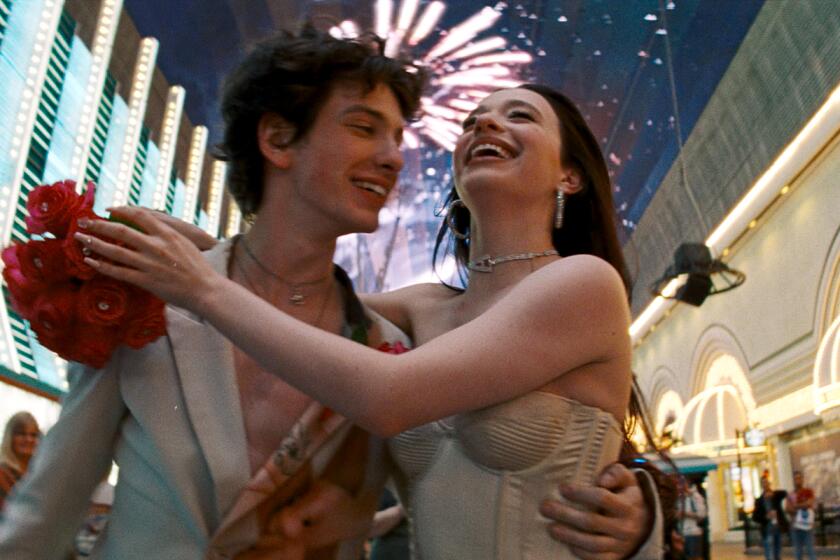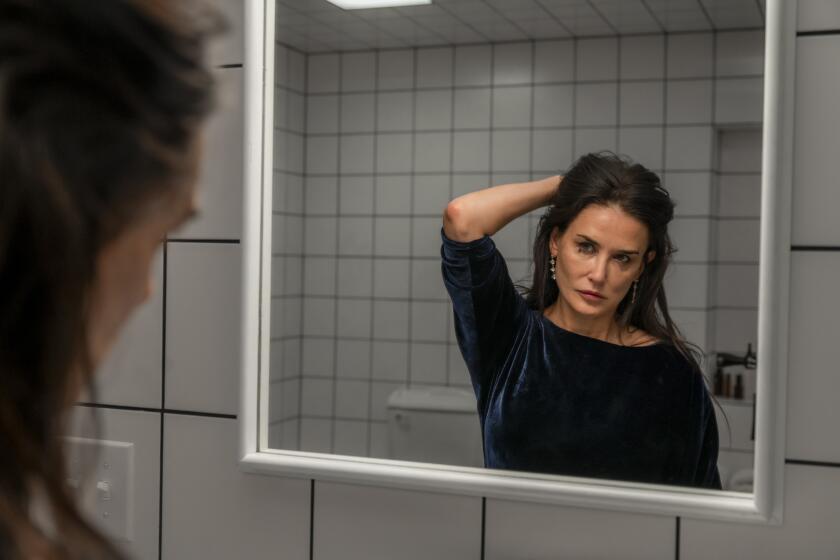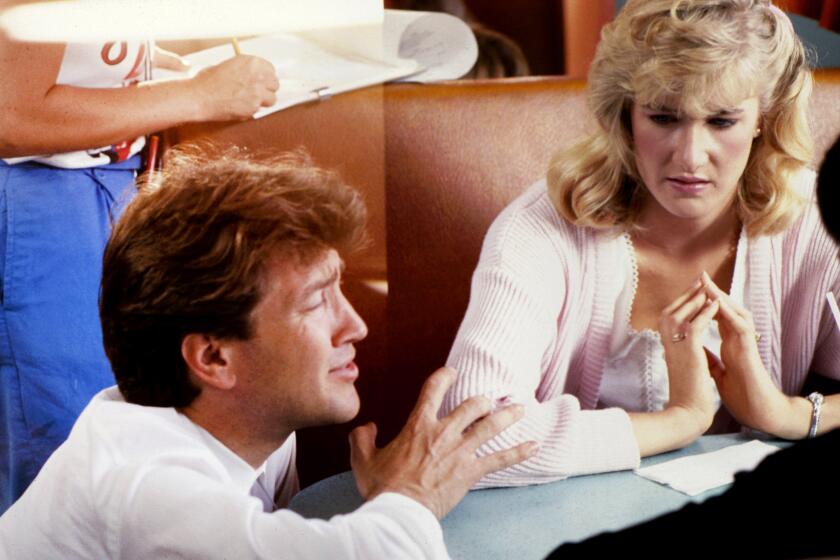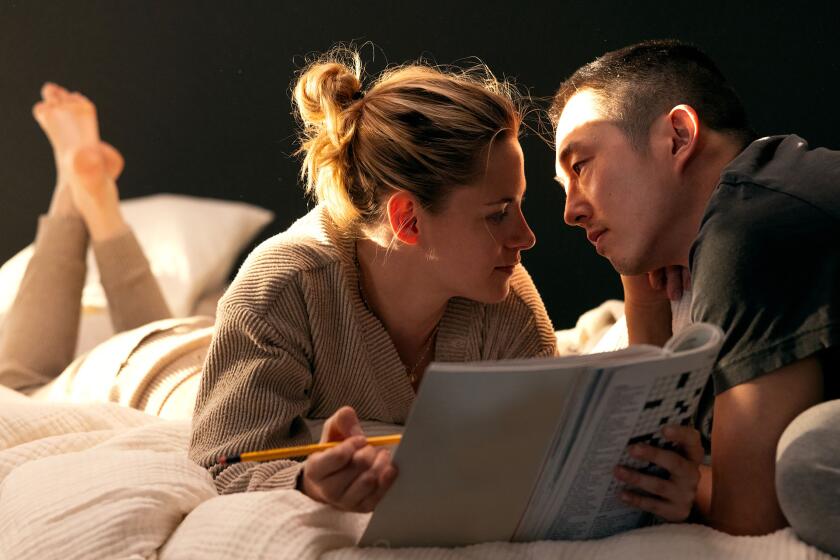In Short Order
- Share via
NEW YORK — When director Steven Soderbergh auditioned Alison Elliott for the role of a temptress in “The Underneath,” he says, “We all looked at each other and said the same thing: ‘Lauren Bacall.’ ”
“Alison really smoked,” says casting director Ronnie Yeskyl, who was at the session. “She was sultry and smoky, and that’s what we were looking for.”
Audiences looking for smoke in Elliott’s newest film, a low-budget indie called “The Spitfire Grill,” are in for a big surprise. According to “Spitfire” director Lee David Zlotoff, her performance as an ex-con who tries to start a new life in small-town New England has some people calling her “the next Jodie Foster” and “the next Holly Hunter.”
Jodie Foster, Holly Hunter and Lauren Bacall?
Not surprisingly, the 26-year-old Elliott looks like none of the above: Her most prominent feature is her arresting blue eyes--which, of course, allows her to act like all of the above, and then some. She’s just flown in from Venice, Italy, where she’s playing what she calls “a high-bred American, 1910,” in Iain Softley’s “Wings of the Dove,” co-starring Helena Bonham Carter, Linus Roache and Elizabeth McGovern.
“It’s sort of a love triangle between an American heiress and this English friend and a young English guy,” Elliott says of the film, which is an adaptation of a Henry James novel. “She’s an orphan and terribly, terribly rich and goes to Europe for an adventure because she’s not well.”
Does this make Elliott the next Gwyneth Paltrow? Cybill Shepherd? Bette Davis?
Like her character in “Wings of the Dove,” Elliott has not been well, although in this case it isn’t some sort of Method acting. She’s been suffering from kidney stones. It was diagnosed in Italian, which she does not speak, so while she’s in New York she’ll get a second opinion. So far it’s cost her one day of work.
“I had a fever, and I’d already been working with a fever,” she says. “I was worried about not being able to finish the film. I can laugh about it now.”
She isn’t laughing when she says it. She does, however, order an onion and lox omelet, though she leaves it mostly untouched. Instead, she smokes a succession of cigarettes, orders more coffee (“Like I’m not wired enough already,” she says) and talks about her ancient Mustang and Oldsmobile. She shows a picture of her dog sitting with her boyfriend, carefully leaving her thumb covering her boyfriend’s face. (She won’t talk about him; they met on the “Spitfire” set.) She says she lives in the Hollywood “flats,” which, she cheerfully admits, is a bit crummy.
“I’ve always been a little wary of something that’s a little too upscale,” she says. “I get a rash if I go into Maxfield’s.”
In short, Elliott’s conversation is commonplace and unpretentious. Ironically, despite the Bacall-like impression she made on Soderbergh, it was these everyday qualities that made her attractive to him in the first place.
“She’s what I call plausibly attractive,” he says. “She looks like somebody you could live near in the place where you grew up. She doesn’t have that sort of over-the-top movie good looks that just pull you out of a film.”
“One of the things I love about Alison is that her face isn’t the same way twice,” says Zlotoff, talking about “Spitfire.” “In some scenes, she looks pretty and vulnerable. In others, you think this is a tough girl. She could be dangerous.”
What’s interesting is that this same girl started out modeling, a profession not always noted for its expressive range. She was born in San Francisco and moved to Tokyo with her family when she was 4. They moved back to San Francisco when she was 8, and later she attended an arts high school. She started modeling when she was 14.
“I just did it part time,” she says. “When everyone was on summer vacation, I was in New York or Tokyo or Paris. It was a good opportunity for me to make my way and have a little professional experience. I was kind of shy.”
After she graduated, she did some more modeling--which she describes as a working vacation, akin to being on location--and then moved to Los Angeles, where she landed a role in the short-lived 1989 television series “Living Dolls.” She made her feature debut in “Wyatt Earp” (1993) as “one of the wives,” as she puts it. Initially she didn’t even know which one it was. (It was Morgan Earp’s.)
“I read these pages for one part, but I knew that I was auditioning for a couple of different parts,” she says. “I got a call and they said, ‘Congratulations, they want you in the film.’ I said, ‘Great, what part?’ Because I had no idea.”
She’ll be the first to admit that no one remembers her in “Wyatt Earp.” However, plenty of people remember her in “The Underneath,” in which she played a schemer who is married to a thug (William Fichtner) and is dabbling with her ex-boyfriend (Peter Gallagher) on the side. This might be described as her breakout film, even though it didn’t do that well. For this, and for whatever shortcomings there are in Elliott’s part, Soderbergh blames himself.
“I really thought she was terrific, and I also felt I didn’t take advantage of her enough in the movie,” he says. “I thought the part was underwritten. That’s my fault, because I wrote it. You’ve got a character in Peter Gallagher who can’t tell the difference between the idea of her and the reality of her. I should have explored the extent to which she exploits his confusion, because that’s what the film is about.”
“I know he looks at it now and bad-mouths it,” Elliott says, smiling. “I’m regretful because I didn’t use him as well as I could have, that I didn’t have the level of experience that would have allowed me to make more of that group of people, make more of that role.”
Nevertheless, the film got her press, which, inevitably, tried to squeeze her into a tight skirt. Hollywood tried to do the same, though she fought that off by doing “The Buccaneers,” from an Edith Wharton novel, for the BBC, and “Indictment,” about the McMartin preschool case, for HBO. It was this sensibility that led her to “Spitfire.”
“Most of the young women in Hollywood scripts have that edge to it,” she says, referring to the emphasis on sexuality. “I’ll read scripts and say, ‘I love this part as the best friend,’ and they go, ‘No, we want somebody quirky’ or something. When I saw this role for ‘Spitfire,’ it really excited me because it was a real character. It wasn’t a girl on somebody’s arm. And she’s somebody very different from me.”
Her character, Percy, works as a waitress at a small-town cafe called the Spitfire Grill, arousing first the suspicion and then the affection of her colleagues (Ellen Burstyn as the flinty cafe owner and Marcia Gay Harden as her nephew’s mousy wife).
Percy has served a stretch in prison--for reasons that become painfully clear--and she’s not the least interested in attracting attention, male or otherwise. Her clothes are baggy, her hair is unkempt, her skin has a kind of a jailhouse pallor. She talks with a heavy backwoods accent. She has an attitude. Like many people who have made a living based on their beauty (in Elliott’s case, during her modeling days), Elliott was more than happy to indulge in this side of the character. It’s the sort of role young women who are forced to trade on their looks want but seldom get until their looks are no longer an issue.
“I was begging for it,” Elliott says. “I was like, ‘Just a little bit more shading under the eyes. No, I don’t want to wear a different shirt. Yeah, OK, you can cover up that one pimple because it’s bad for continuity, but otherwise no mascara.’ I didn’t want to look so healthy, so put together, so brushed out or groomed.”
Perhaps fortunately, “Spitfire” director Zlotoff had not seen “The Underneath” when he cast her, so he didn’t have any preconceptions about how Elliott looks on screen or how she was willing to look on screen. And the fact that she was unknown, while making the film more difficult to market, does help sell her character to an audience. Zlotoff says her accent is so seamless that people just assume she’s from the South. However, even though she doesn’t share Percy’s background, Elliott does share some of Percy’s fight.
“She knew what she felt was right for the character and was willing to say it, which I thought was great,” Burstyn says. (Apparently there was plenty of opportunity to say it. The filmmakers cut 50 scenes out of the movie, challenging the actors and the director to make sense of what was left.) “A lot of young actresses would demur and do what they’re told. She’s a real actress, not a model.”
“Spitfire” won an Audience Award at the Sundance Film Festival and was picked up by Castle Rock for a record $10 million. It also piqued the interest of Miramax Co-Chairman Harvey Weinstein, who approved of Elliott for “Wings of the Dove.” She says he encouraged her to sign a two-picture deal, but she declined.
For the moment, she remains interested in scripts, not deals--or stardom. She doesn’t anticipate a “Speed” in her future.
“I don’t see seeking that out,” Elliott says. “If there’s a catapult around, I figure I’ll stumble on it unwittingly. It might feel a little more like a land mine than a catapult. And it’ll probably be because I loved something and then it got seen a certain way.”
As Zlotoff observes, “No one says she’s the next Sharon Stone.”
More to Read
Only good movies
Get the Indie Focus newsletter, Mark Olsen's weekly guide to the world of cinema.
You may occasionally receive promotional content from the Los Angeles Times.










